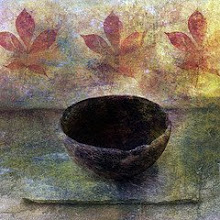 Change is a central feature of life. It can be exhilarating, frightening, exhausting, or relieving. It can spark sadness or happiness, resistance or grasping.
Change is a central feature of life. It can be exhilarating, frightening, exhausting, or relieving. It can spark sadness or happiness, resistance or grasping.Insight into impermanence is central to Buddhist practice. Buddhist practice points us toward becoming equanimous in the midst of change and wiser in how we respond to what comes and goes. In fact, Buddhism could be seen as one extended meditation on transience as a means to freedom. The Buddha’s last words were: “All conditioned things are impermanent. Strive on with diligence.” The solution to suffering is to transcend the world of impermanence.
The Buddha approached suffering differently. He said that suffering is not inherent in the world of impermanence; suffering arises when we cling. When clinging disappears, impermanence no longer gives rise to suffering. The solution to suffering, then, is to end clinging, not to try to escape from the transient world.
One means of reducing clinging is to see the transient nature of what we cling to. This insight can either show us the futility of trying to find lasting happiness in what is impermanent, or it can encourage us to examine deeply why we cling.
Impermanence can be understood in three ways. First, is the obvious, ordinary understanding of impermanence. Second, is understanding from insight, from the intuitive, direct seeing of the nature of things. Finally, there is the way in which seeing impermanence can lead to liberation.
The ordinary understanding of impermanence is accessible to all; we see old age, sickness and death. We notice that things change. The seasons change, society changes, our emotions change, and the weather changes. Sometimes, realizing that an experience is impermanent, we can relax with how it is, including its coming and going. Other times, seeing that change is inevitable helps us to let go of clinging to how things are or resistance to change. And sometimes recognizing that we are all equal in being subject to aging, sickness, and death is the basis for compassion.
Beyond the ordinary experience of impermanence, Buddhist practice helps us open to the less immediately perceptible realm of impermanence, i.e., insight into the moment-to-moment arising and passing of every perceivable experience. With deep concentrated mindfulness, we see everything as constantly in flux, even experiences that ordinarily seem persistent.
Perhaps you have had an opportunity to bring mindfulness to a strong physical experience such as pain. We tend to see pain through our ideas about it. With very strong mindfulness, however, we find that we can't pinpoint pain; as soon as we think we have located the pain, it flashes out of the existence and reappears a millimeter to the side. It becomes a dance of sparking sensations located in no particular place. Pain that seemed solid is actually in constant flux. In this deeper experience of impermanence, we realize that it doesn't make sense to hold onto anything, even temporarily. There's nothing that we can hold onto because everything simply flashes in and out of existence.
We also realize that our clinging and resistance have very little to do with the experience itself. We mostly cling to ideas and concepts, not things or experiences in and of themselves. For example, we don’t cling to money, but to the ideas of what money means for us. We may not resist aging as much as we resist letting go of cherished concepts of ourselves and our bodies. One of our most ingrained attachments is to self, self-image, and self-identity. In the deeper experience of mindfulness, we see that the idea of self is a form of clinging to concepts; nothing in our direct experience can qualify as a self to hold onto.
As we see impermanence clearly, we see that there is nothing real that we can actually cling to. Our deep-seated tendency to grasp is challenged, and so may begin to relax. We see that our experiences don't correspond to our fixed categories, ideas, or images. We realize that reality is more fluid than any of our ideas about it.
Confronting impermanence profoundly, in this meditative way, can open us to liberation. Ajahn Chah once said, “If you let go a little, you’ll have a little peace. If you let go a lot you’ll have a lot of peace. If you let go completely, you’ll have complete peace.” This release is sometimes called Mahasukha, the Great Happiness, which is said to be the only happiness that is ultimately reliable.

Dear Sir,
ReplyDeleteI read daily one post of you site.Very lucid and simple explanation. Thanks.
-Vinay
Vinay-
ReplyDeleteThank you for your taking the time to post your encouraging comments.
Blessings,
d